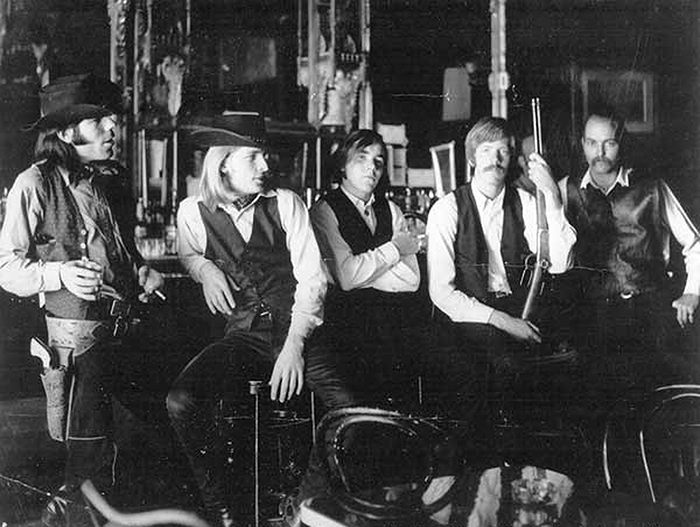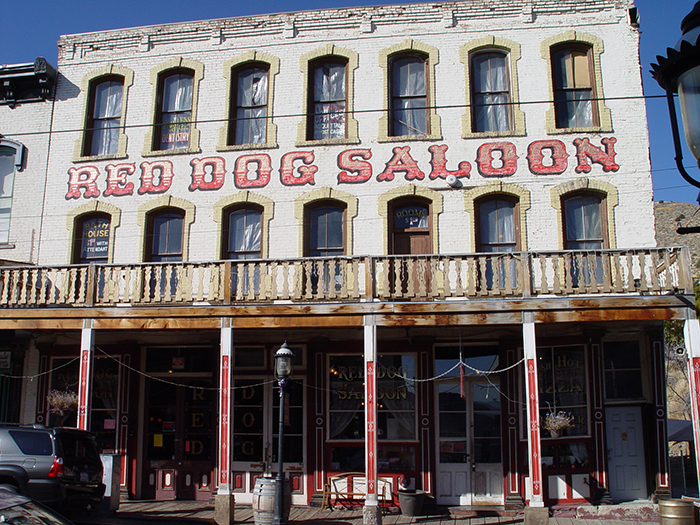The Comstock Summer of Love at 50
May – June 2015
Red Dog Saloon celebrates a time when rock ’n’ roll counterculture ruled the joint.
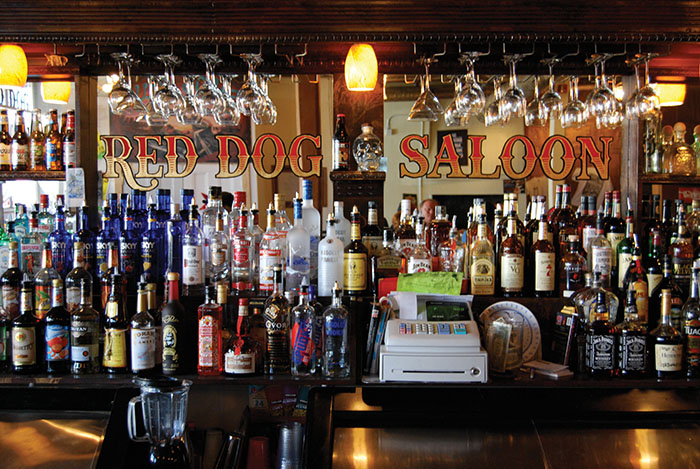
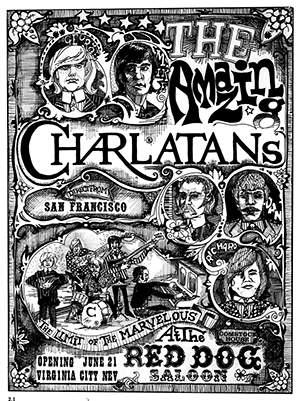
Long before burners engulfed the playa of Nevada’s Black Rock desert or steampunkers rocked their first Comstock counterculture balls, there was the Red Dog Saloon. From June to August of 1965, this establishment-defying enclave on C Street in Virginia City made history by launching the Charlatans—a music-fused mix of rock ’n’ roll, costumes, guns, and mind-skewing substances. The brick-stout, vermillion-tinted Red Dog building was ground zero for risky, experimental behaviors in a developing psychedelic cultural esthetic known as the “San Francisco Sound,” which in turn cross-fertilized the Bay Area’s 1960s counterculture.BY ENGRID BARNETT
The Charlatans embraced Hollywood-inspired place images associated with Virginia City, donning Wild West outfits, side arms, and long rifles, and playing along with the “Gunsmoke”-inspired antics of the Red Dog’s owners and operators, Mark Unobsky, Don Works, and Chandler Laughlin III (known to radio listeners and Comstock residents for decades later as Travus T. Hipp). Elements of the Bay Area youth scene in turn shaped the Red Dog and the Charlatans, whose LSD-laced audition was legendary, and who promoted their opening performance with a pioneering psychedelic poster, still known as “the Seed,” drawn by bandmates Michael Ferguson and George Hunter.
The Red Dog venue had attractions, including an old-timey frontier stage, a trippy light show machine created by Bill Ham and Bob Cohen, and plenty of floor space where unabashed participants (and curious locals) could dance. Gourmet French fare by the saloon’s acclaimed chef Jenna Worden drew locals including Bohemian railroad fanatic and author Lucius Beebe, his partner and photographer Charles Clegg, and Mustang Ranch entrepreneur Joe Conforte, ever-accompanied by a complement of body guards. As word spread from San Francisco across the Pacific Northwest, a ragtag core of musicians, artists, latter-day Bohemians and Beatniks, and itinerant travelers came to visit. Often dressed like Edwardian and Victorian toffs and sometimes dosed on hallucinogens, their experiment involved a radical new way of living and building community. Flawless views from Mount Davidson enhanced the libertine experiences of the arrivals. A narrow focus on the tourist trade in 1960s Virginia City encouraged “Red Doggers” to actively participate in the production of pop culture-inspired place images while wearing frontier costumes, packing firearms, and acting out their adolescent fantasies of Hollywood film Westerns.
By mid-August of 1965, however, rumors of illicit drug use, too many firearm incidents, and alleged game poaching swirled around the Red Dog and its regulars. A drug bust in Rodeo, California, of the Charlatans’ guitarist, Mike Wilhelm, and Red Dog front-man, Chan Laughlin appeared to confirm what was whispered around the Comstock. Add to that an unexpected and unwelcome visit from the acid-addled Merry Pranksters in their Day-Glo “Furthur” bus and these events gave a provocative punctuation to the summer.
The madcap story of the Charlatans and the Red Doggers’ desert high jinks could not be easily squelched. Instead, they rode a wave of innovative inspiration back to San Francisco, ultimately helping to birth some of the most iconic elements of the Counterculture movement culminating in 1967’s “Summer of Love.” Emphasizing the continued influence of the Red Dog gang after their return to the San Francisco scene were original participants Luria Castell, Ellen Harmon, and Alton Kelley who, along with Jack Tolle, created Family Dog to promote the Charlatans and the “Red Dog” way of being. Drugs, psychedelic posters, light shows, and costumes were already trickling into the Bay Area scene, but the movement inherited a condensed, Wild West-inspired boost from the Red Dog Experience that the Charlatans and Family Dog perpetuated with unique style, imagery, and promotions.
Fast forward fifty years to this summer’s weekend of June 19-21, which marks the golden anniversary of the Charlatans’ debut at the Red Dog. To commemorate this iconic countercultural event, the four surviving members of the original lineup (George Hunter, Dan Hicks, Richard Olsen, and Mike Wilhelm) along with famed folk music trio the Scragg Family (who were the house band at the Red Dog during the summer and fall of 1967) are returning to a revitalized and renovated Red Dog Saloon.
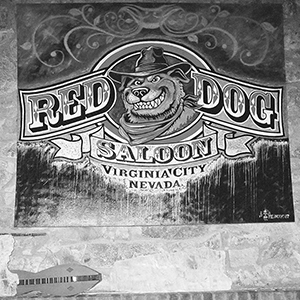
In conjunction with this momentous weekend, the Nevada Historical Society will feature a museum exhibit I have guest curated, in place from June 6 to Sept. 30, which takes a closer look at the draw of Nevada’s enigmatic landscape and the legends that inspired elements of the libertine, countercultural movement at the 1965 Red Dog. The museum will host a free opening reception, Saturday, June 6, from 5:30-7 p.m. featuring a guest lecture panel with original “Red Dog” participants and members of the Charlatans. Entitled “Sagebrush Psychedelic: At Play in the Desert,” the exhibit will present a multi-sensory exploration of Nevada place images, tourism, fantasy, and play highlighting the Charlatans, the Comstock, and today’s countercultural life sketched in a similar vein, namely through Burning Man.Under the ownership of Loren and Sue Pursel, the Red Dog Saloon is enjoying a renaissance, complete with a new version of the legendary mascot, a Rottweiler named Ruby the Red Dog. Tastefully redesigned to emphasize the best features of its fabled nineteenth-century and eclectic twentieth-century hybrid heritages, the Red Dog will provide twenty-first century visitors with a rich taste of the Comstock’s psychedelic past. Performances begin June 19 at the Red Dog Saloon with the Scragg Family (Peter Feldmann, Kajsa Ohman, and Ray Bierle). The Charlatans (with special guests Freddie Steady Krc of the Jerry Jeff Walker Band on drums and Tom Constanten from the Grateful Dead on keyboard) will perform Saturday, June 20, at Piper’s Opera House (12 B Street) before heading over to the Red Dog for a once-in-a-lifetime meet and greet. Accompanying their concert will be a light show by Bill Ham, co-creator of the 1965 Red Dog’s light machine and inventor of liquid projection. The Charlatans will officially return to the stage of the Red Dog Sunday, June 21 to perform, offer remarkable reminiscences of 1965, and punctuate the evening with unexpected and highly anticipated “Red Dog Experience” theatricals.
For more information and to purchase tickets, please contact:
The Nevada Historical Society
1650 N. Virginia St.
Reno, NV 89503
775-688-1190
Museum Admission Prices: $5 for those 18 and over, free for those 17 and under and for Nevada State Museum Members
Free Opening Reception (with light hors d’oeuvres and wine): Saturday, June 6, 5:30-7 p.m.
The Red Dog Saloon
76 N. C St.
Virginia City, NV 89440
reddogvc.com, 775-847-7474
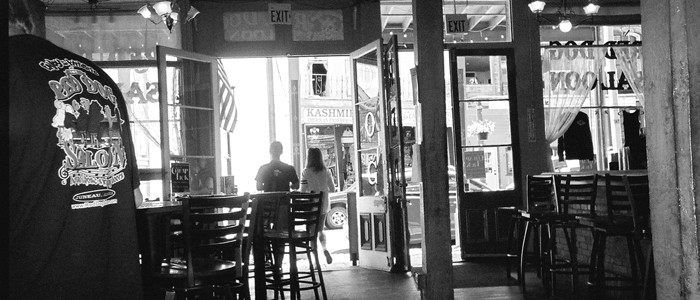
Ticket Information:
Friday, June 19, 8 p.m.: The Scragg Family at the Red Dog Saloon – $10
Saturday, June 20, doors open at 7 p.m.: “A Night at the Opera” with the Charlatans and Bill Ham Lights at Piper’s Opera House- $75
Saturday, June 20, Time: TBD: Post-concert “Meet and Greet” with the Charlatans following the Piper’s Opera House performance- $25
Sunday, June 21, doors open at 7 p.m.: The Charlatans at the Red Dog Saloon with “Red Dog Experience” theatricals – $100
A discount ticket for all events is $175

